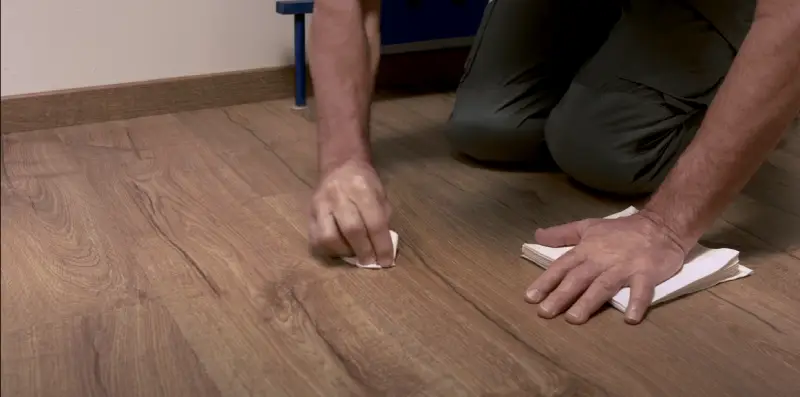Every homeowner dreams of having spotless, shiny floors. However, the reality often differs. Scuff marks, those black or gray streaks, can appear on various types of flooring due to shoes, furniture, and general wear and tear. Fortunately, with just a few simple steps, you can remove those scuffs and get your floors looking as good as new again, ensuring they stay pristine and durable.
How To Remove Scuff Marks From Wood Floor
Wood floors are elegant but delicate, requiring gentle care to avoid damage. Start by vacuuming and wiping them with a microfiber cloth to remove dirt. For light scuffs, use a soft cloth and a specialized wood floor cleaner. If the scuffs are really stubborn, you might need something stronger like a special eraser for wood floors or a cleaner that’s pH-neutral. Sometimes, stuff like nail polish remover or a mix of vinegar and olive oil can also work. Finish the cleaning process with a polish made for wood floors to make them shine. Just remember to test these methods in a small area first to make sure they don’t harm your floor.
How To Remove Scuff Marks From Floor Vinyl
Vinyl flooring is durable and responds well to various cleaning methods. To remove scuff marks, mix some warm water with a cleaner for vinyl floors or just some regular dish soap. Use this mix to gently scrub the marks with a soft cloth or a brush that’s not too hard. If the marks are still there, try using a foam eraser. After cleaning, rinse the floor with water and use a protective spray to keep scuffs away in the future.
How To Remove Scuff Marks From Tile Floor
Tile floors can handle stronger cleaning solutions. Use a pH-neutral cleaner for everyday cleaning, but if you have scuff marks, you might need a stronger one. Scrub the marks using a pad in circular motions. Always dry the tiles after cleaning and put on a tile sealer to protect them. If you don’t like using strong cleaning products, try making a paste with baking soda and warm water, or use a cloth with some nail polish remover for the tough marks.
How To Remove Scuff Marks From Hardwood Floor
Hardwood floors demand a gentle yet effective approach. Always begin by vacuuming and wiping away the dirt. To get rid of scuff marks, apply a small amount of hardwood-specific scuff remover with a microfiber cloth, using gentle pressure. You should avoid water-based cleaners and always finish with a wood polish. You can also try removing marks with nail polish remover or a mix of vinegar and olive oil. Sometimes, lightly sanding with fine-grit sandpaper helps too.

How To Remove Scuff Marks From Epoxy Floor
Epoxy floors, known for their durability, need proper maintenance, including standard and deep cleaning methods. For scuff marks, use a non-abrasive cleaner specifically designed for epoxy flooring, or a mix of water and mild dish soap. Use a soft mop or cloth for light marks. If they are still there, you might need a floor buffer with a soft pad, or a cloth dampened with rubbing alcohol. Always rinse the floor with water after cleaning, dry thoroughly to prevent water spots and apply a special coating for epoxy floors to protect them.
How To Get Scuff Marks Off Laminate Wood Floors
Laminate floors are different from traditional hardwood. They are durable but can be sensitive to certain cleaners. Use a gentle laminate floor cleaner to remove scuff marks, or a solution of water and vinegar or baking soda. Scrub the marks gently with a soft cloth or mop and then rinse it off. Be careful not to use strong chemicals that can damage the laminate’s protective layer.
How To Fix Scratches On Wood Floor
Scratches on wood floors can be annoying. For small scratches, a DIY solution is to mix equal parts apple cider vinegar and olive oil and apply it to the scratch. Wait a few minutes, then wipe it off with a soft cloth. You can also rub a walnut over small scratches – it sounds strange, but the oils in the walnut can darken the wood and hide the scratch, especially on dark floors.
For deeper scratches, wood filler is a good choice. Pick a filler that matches your floor color, fill in the scratch, let it dry, and then gently sand it. Finish by putting on some wood stain and sealant that matches your floor. Colored wax sticks are another good option. After you apply the wax, buff the area to blend it in. For deeper scratches, wood stain pens are handy. They’re easy to use – just color the scratch with the pen. Always pick a color that’s close to your floor.
To prevent scratches, use protective pads under furniture legs, keep pet nails trimmed, and don’t wear shoes that may cause damage. Regularly cleaning and polishing with the right products will keep wood floors looking their best.
